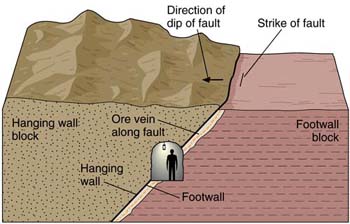
Faults
| When a rock breaks rather than folds we have a fault. Faults are classified by the relative motion along the fault plane. The two terms necessary for understanding fault motion are the hanging wall and the footwall. These terms undoubtedly have their origins in mining. Mines are often located along faults where valuable mineral deposits are often found. As mines were dug along a fault, which is usually slanted at some angle, one side of the mine would be on one side of the fault and the other side of the mine would be on the other side of the fault. Because most faults are slanted and not vertical, the roof of the mine would be on a different side of the fault than the floor of the mine. Now, because miners would hang their lanterns on the roof and put their feet on the floor, the upper portion was called the hanging wall (sometime also called the headwall) and the lower portion was called the footwall. |
 |
|
Normal Faults When rocks are subjected to tensional stresses a normal fault will form. In this case the headwall block will move down relative to the footwall block.
|
 |
|
Reverse and Thrust Faults When rocks are subjected to compression stresses a reverse or thrust fault will form. In this case the headwall block will move up relative to the footwall block. The only difference between a reverse fault and a thrust fault is the angle of the fault plane. A thrust fault is a low angle reverse fault.
|
 |
Strike Slip Faults
 When
rocks are subjected to shear forces, a strike slip fault will form. Because the
fault plane is normally fairly vertical, the terms hanging wall and footwall are
meaningless. Here the fault blocks move laterally past one another. The fault
blocks can move past each other towards the left (in left lateral strike
slip faults) or toward the right (in right lateral strike slip faults). In order to
determine which way the fault moved, imagine you are standing on one side of the
fault looking across at the other side. If objects on the other side appeared to
have
moved towards your right then it is a right lateral strike slip fault. If
objects on the other side appeared to have moved towards your left then it is a left
lateral strike slip fault. It doesn't matter which side of the fault you are
standing on, so long as you are looking ACROSS to the other side you will get
the same answer.
When
rocks are subjected to shear forces, a strike slip fault will form. Because the
fault plane is normally fairly vertical, the terms hanging wall and footwall are
meaningless. Here the fault blocks move laterally past one another. The fault
blocks can move past each other towards the left (in left lateral strike
slip faults) or toward the right (in right lateral strike slip faults). In order to
determine which way the fault moved, imagine you are standing on one side of the
fault looking across at the other side. If objects on the other side appeared to
have
moved towards your right then it is a right lateral strike slip fault. If
objects on the other side appeared to have moved towards your left then it is a left
lateral strike slip fault. It doesn't matter which side of the fault you are
standing on, so long as you are looking ACROSS to the other side you will get
the same answer.
|
|
Back to previous page |
Next page |
|